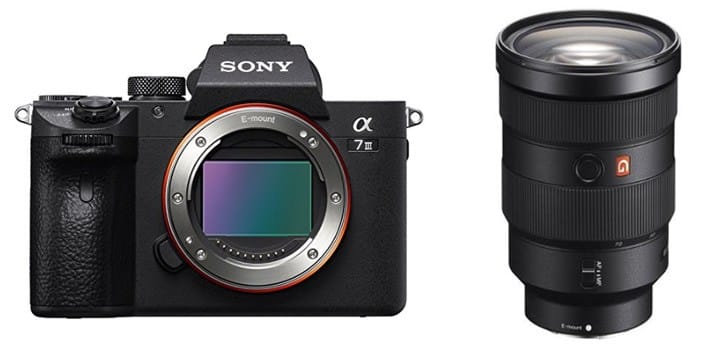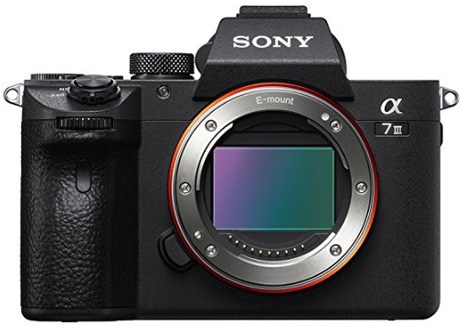Trying to figure out what is the best lens for your Sony a7 III? That’s going to depend on the type of photography you plan to shoot. The a7 III is an excellent all-around FF camera and so the lenses you will find in this guide are perfect for many different types of photography.
With a 24MP sensor, 10 frames per second, 4K video and built-in image stabilization, it doesn’t matter what you’re doing; the camera is great for any scenario.
However, the better your camera, the better your lenses should be. Otherwise, you have this amazing sensor but no way of getting the best image quality out of it. The lenses you mount on it matter the most!
We made sure to focus on high image quality, sharpness and usability. Sony’s lens selection has constantly been growing, and there are plenty of amazing prime and zooms available. For reference, the a7 III uses the Sony E-mount.
Best Sony Zoom Lenses:
Sony 12-24mm f/4 G
Sony 16-35mm f/4 ZA OSS
Sony 24-70mm f/2.8 GM OSS
Sony 24-240mm f/3.5-6.3 OSS
Sony 70-200mm f/4 G OSS
Sony 70-200mm f/2.8 GM OSS
Sony 70-300mm f/4.5-5.6 G OSS
Sony 100-400mm f/4.5-5.6 GM OSS
Best Sony Prime Lenses:
Zeiss Batis 18mm f/2.8
Zeiss Batis 25mm f/2
Sony 35mm f/2.8 ZA
Sony 50mm f/2.8 Macro
Sony 50mm f/1.4 ZA
Sony 55mm f/1.8 OSS
Zeiss Batis 85mm f/1.8
Sony 85mm f/1.4 GM
Sony 90mm f/2.8 Macro G OSS
There isn’t one best lens for everything, and while some of you prefer shooting with an all-around zoom, someone might be looking for a couple of prime lenses. Our guide covers it all.
We’ve checked out a whole lot of lenses for the a7 III and the ones we picked belong either to Sony or Zeiss, which is no surprise as they’ve been a perfect couple for a long time.
Since you can use an adapter to mount lenses from other brands, we didn’t include them as that would truly be an enormous, and not a fair list. The 17 lenses that made it on our list are what we believe is a perfect combination of price, usability and optical performance. If you own something else or are about to and it’s not in this guide, it does not mean you shouldn’t use it with your camera.
Best Sony Zoom Lenses:
If you decide to buy anything after clicking on our Amazon links, you automatically support us. It’s what allows us to write guides such as this one.
1. Sony 12-24mm f/4G
Best extreme wideangle for landscape, real estate and astrophotography

The Sony 12-24mm f/4 G is the most open wide angle lens available in Sony’s full-frame E-mount series.
This ultra wide angle is the perfect lens if you happen to love landscape and architecture photography. The constant f/4 aperture gives you enough starting depth of field to work with, making faster apertures unnecessary. The lens is also compatible with Sony mirrorless cameras with APS-C sensors where it creates a focal range of 18-36mm.
The FE 12-24mm G is also designed for weather resistance with rubber rings preventing dust, moisture, and splashes from entering the lens barrel. The weather protection also grants extra cold resistance to the lens.
Sony’s G lenses are carefully calibrated to ensure incredible clarity and resolution. They’re also designed with bokeh in mind. The FE 12-24mm has seven rounded aperture blades designed to help create incredibly pleasing bokeh for out of focus zones.
The glass of this lens also has a Nano AR coating to help prevent flare and ghosting from incidental light sources. This improves the contrast and clarity of the overall image. The lens barrel has a customizable focus hold button for additional flexibility. At 1.25 lbs (20 oz) this lens is bulky but remains an incredibly capable tool for the wide angle enthusiast.
You can buy it at Amazon or see more reviews here.
2. Sony 16-35mm f/4 ZA OSS
Best wideangle for landscape, streets, indoors
The Sony 16-35mm f/4 ZA OSS is a versatile, sharp lens for all sorts of landscape and wide angle situations.
If you prefer wide zooms over primes, there’s no better lens, especially at this price. The colors, contrast and sharpness are all great. While it’s usable at f/4, the corners might be a little too soft for some, at least when above 28mm.
Specification wise, the 16-35mm f/4 features AA (advanced apsherical) and 3 ED elements that help control the chromatic aberration and show less distortion. There’s also T* coating to reduce the flare and ghosting. It displays normal signs of vignetting and distortion for when under 20mm, but both can be corrected if needed.
It weighs 18.3 oz (518g) and it balances nicely on all a7 bodies. It’s not heavy either, but if you’re looking for something even lighter we recommend buying 2 primes. Its minimum focus distance is 0.92 ft (0.28m) but it’s nothing to use as a lens for close up shots with 0.19x magnification. The lens is aimed at indoor, street, landscape and group shots scenarios and it excels at that.
Aperture stays fixed at f/4 at all lengths which seems to be a standard with the majority of Sony’s lenses. An f/2.8 16-35mm would probably be too big and heavy for most, but we’re sure that slowly more and more f/2.8 zooms will arrive. However, if most of your work is done outdoors then there’s no point in anything bigger than f/4, which isn’t that small anyways.
You can buy it at Amazon or see more reviews here.
3. Sony 24-70mm f/2.8 GM OSS
Best low light, optically great all-around zoom
There’s an f/4 of this lens but for the price it’s definitely not worth it, at least if image quality is your main concern. If it would be substantially cheaper we would probably consider it as a good value for the money, but for now the Sony 24-70mm f/2.8 GM takes this spot.
Yes, it’s big and heavy (31.25 oz/885g), so if these two are your main concerns then an f/2.8 zoom will probably never be a part of your kit. It’s also expensive, sitting at $1000 more than the f/4 version.
With that in mind, the optical quality is as expected from Sony’s GM series, at both 24 and 70mm lengths (and between). The f/2.8 opening provides plenty of light when working in low light situations so it’s an excellent wedding, portrait, concert and walk-around lens when a zoom is more handy than a fixed lens. The walk-around part we mentioned is assuming you’re okay with the weight, but the length covered is ideal for traveling!
On the inside we can see a few reasons for the price; it has 1 x Extreme Aspherical element (XA), 2 x Aspherical elements, 1 x Super ED and 1 x ED element. You’re looking at 18 elements in 13 groups so the size is no surprise. It’s similar to both Canon and Nikon 24-70mm f/2.8 versions; optical quality is superb, but none of them are stabilized. Luckily you don’t have to worry about that with the Sony a7 III body.
The auto focus is really fast and accurate thanks to DDSSM and it’s perfect for locking on fast moving subjects. All of that comes with a big price tag, but it’s worth it.
You can buy it at Amazon or see more reviews here.
4. Sony 24-240mm f/3.5-6.3 OSS
The only all-around, big zoom
 As if big the lens above wasn’t bulky enough, we present the Sony 24-240mm f/3.5-6.3 OSS. It’s a tad lighter and smaller, but on an a7 body, both will make the camera look tiny.
As if big the lens above wasn’t bulky enough, we present the Sony 24-240mm f/3.5-6.3 OSS. It’s a tad lighter and smaller, but on an a7 body, both will make the camera look tiny.
The lens is ideal if you’re looking for 1 single lens that can do it all with good image quality and 10x zoom. The image quality obviously can not match that of prime lenses, but it’s not competing with them. The 24-240mm is something you take with you when switching between different lenses and carrying a ton of equipment sounds like it’s going to stop you from taking pictures. We’ve all been there and it’s something we often forget before purchasing gear. Image quality is one thing, carrying all that stuff is another.
It weighs 27.6 oz / 780g and costs less than $900. Surprisingly, the lens is very good at controlling vignetting, chromatic aberration and distortion, which for such a big zoom is really awesome. Colors and sharpness are also quite good, but again not on the level of primes. Another downside is also f/6.3 at 240mm. Outdoors you’ll probably fine in most situations, but as soon as it gets darker you’ll have the raise the ISO speed or use a tripod. OSS helps, but at 240mm it’s easier to get a blurred shot than at 24mm.
With a big zoom you always have to make some compromises, but it’s good knowing that the actual quality of the shots is far from bad.
You can buy it at Amazon or see more reviews here.
5. Sony 70-200mm f/4 G OSS
Best for sports, animals and telephoto work
The Sony 70-200mm f/4 G OSS was released in 2014 and was for quite a long time the only Sony telephoto lens good for professional use.
Like with every 70-200mm from other brands, Sony delivered. The f/4 versions has very quick auto focus and the image quality is top notch. It’s failry compact for an 70-200mm zoom, and is much much lighter than the f/2.8 version. It’s also $1200 cheaper, and that, along with the weight difference, played a big role on putting this lens on our most recommended zoom list.
The reach is very versatile and perfect for portraits, animals, sports, landscape, concerts and much more. You’ll have to shoot with a higher ISO when indoors, but for the price, quality and relatively compact size, this is the best telephoto available. When zooming or focusing, the lens doesn’t extend or rotate, which is good if you’re using filters. Speaking about filters, the diameter is 77mm. Its minimum focus distance is 3.15 feet and it has a 11-blade aperture for getting that beautiful, circle bokeh.
The f/2.8 version was announced in early 2016 and is definitely more suitable for concerts and weddings, although the high ISO performance of new Sony alpha cameras is good, even on the megapixel monster a7 III so it’s not like those are impossible to shoot with an f/4 lens.
You can buy it at Amazon or see more reviews here.
6. Sony 70-200mm f/2.8 GM OSS
Best indoor and outdoor action, portraits, weddings, concerts, …

Same zoom capability, but 1 stop bigger aperture. The Sony 70-200mm f/2.8 GM OSS is a lot more expensive, but for certain photographers the advantages are super important.
For indoor sports with bad lighting, having f/2.8 is crucial. It’s also perfect if you’re looking to blur the background, or shoot outside really early/late during the day. You can always raise your ISO speed, but certain models don’t perform as good as others. One aperture bigger may not sound a lot, but that allows you to shoot with (an example) 1/500 instead of 1/250, which is enough to really freeze the motion.
While image quality is very similar with both, the f/2.8 version features 11 vs 9 diaphragm aperture blades, slightly shorter minimum focus distance, bigger magnification (0.25x vs 0.13x). Naturally, its auto focus performance is excellent as well, with silent, fast and precise AF.
Any issues? As you’d expect, it’s heavier and bigger than the f/4 version. It could easily be too heavy if you’re using the A6 and aren’t used to bigger lenses.
The f/2.8 is also a lot more suitable for weddings, concerts or any other indoor activity. If you’re into those types of photography besides sports and wildlife, this is something you should consider if you can’t decide between the 2 versions.
You can buy it at Amazon or see more reviews here.
7. Sony 70-300mm f/4.5-5.6 G OSS
Best wildlife and outdoor sports telephoto
The Sony 70-300mm f/4.5-5.6 G OSS is your best wildlife/birds/outdoor sports Sony right now.
Going an extra 100mm further than the telephoto above, you do lose one aperture stop worth of light as it closes down to f/5.6 at 300mm. However, for outdoor use where you’ll most likely use it anyways, it will be excellent! Combined with the built-in OSS and good ISO performance, you don’t have to worry that much when the day gets darker.
For around $1000, you know the image quality better be good, and thanks to 2 x ED elements and 4 x aspherical elements, the aberration control and ghosting are very good. It delivers sharp images with good contrast and colors even when at 300mm. Ghosting is a common issue when shooting at long lengths so the Sony Nano AR coating helps tremendously.
As far as weight is concerned, it’s only a tad heavier than the 70-200mm f/4, but this is a common thing with telephoto lenses.
Auto focus is also quick and capable of focusing on fast moving subjects. There’s no point in a telephoto lens that can’t focus well, even if it’s optically amazing.
You can buy it at Amazon or see more reviews here.
8. Sony 100-400mm f/4.5-5.6 GM OSS
Most reach, best for small birds and wildlife

The Sony 100-400mm f/4.5-5.6 GM OSS was released in mid-2017 and is a wish come true for many Sony photographers.
With many outdoor sports, you know that you can never have too much focal length. 400mm is a whole different world compared to 300mm and you’ll be able to get even closer to the action. Since this lens is quite expensive, we do recommend you to try something else first if you’re not too sure you even need anything over 300mm.
On APS-C models such as the A6500, the 100-400mm is actually equivalent to a 150-675mm. Talk about length!
Let’s talk about the cool features of the 100-400mm. First, you can adjust how much torque the zoom ring has so you make it faster or slower, depending on your preferences.
The OSS (stabilization) works in 5-axis, it’s got 9 diaphragm blades for smooth background blur and a focus limit button to limit how far away the lens can look for focus.
Speaking about focus, AF is very quick, silent and precise, a must for any wildlife/sport activity. You can definitely count on getting some amazing crisp shots.
You can buy it at Amazon or see more reviews here.
Best Sony Prime Lenses:
1. Zeiss Batis 18mm f/2.8
Sharp prime for travel, landscape, indoors, astrophotography
Batis lenses are designed by Zeiss and offer auto focus, as well as bunch of other solid features (weather sealing etc.). Image quality, as expected from this company, is also top notch in the Batis line.
The Zeiss Batis 18mm f/2.8 is our top pick for the ultra-wide photographer shooting landscape, streets and astrophotography. It is sharp across the entire frame and is usable at f/2.8. Definitely worth the price and the contrast and colors are also superb.
It has Zeiss’ T* coating for reduced flare and it also displays minimal amount of chromatic aberration. We mentioned it’s appropriate for astrophotography too, mostly thanks to near-zero visible coma.
Some other cool features; there’s an OLED screen on top that you can turn on/off, it has good auto focus and it feels very solid.
Because of the big aperture (f/2.8 to f/22) and good sharpness, the Batis 18mm is great for interior, street, architectural and nature photography. While auto focus is usually not a concern for landscape uses, it helps knowing that when needed, it’s quick and quiet. The ring for manual is focusing is rubberized although we find AF to be a better choice due to the way it’s designed.
You can buy it at Amazon or see more reviews here.
2. Zeiss Batis 25mm f/2
Sharp lens for landscape, streets and low light
 Is 18mm too wide for you? The Zeiss Batiss 25mm f/2 is another slightly longer, yet brighter tack sharp prime beauty.
Is 18mm too wide for you? The Zeiss Batiss 25mm f/2 is another slightly longer, yet brighter tack sharp prime beauty.
It’s quite similar to the one above, but costs $200 less. You get an OLED display for previewing the depth of field and focus distance highlighting, fast AF thanks to the linear motors and a floating elements design style. Due to this, both lenses are sharp regardless of how close your subject is and deliver optically great results at all aperture sizes. There’s also T* coating for better contrast and less ghosting, as well as a dust and weather-sealed construction (like all on our list).
The lens weighs almost as much as the 18mm above (11.82 oz/335g) but is shorter in length. Minimum focus distance is 7.87″ (20 cm) so you can also use it to get some cool close shots.
The biggest difference, besides the price and focal length, is one stop bigger max. aperture (f/2 instead of f/2.8). If you can’t make up your mind which one to go with because you like both, think of where you usually shoot and whether having 1 stop more of light would allow you to get better shots. For 99% landscape and daytime photography, f/2.8 is already more than enough. That’s not to say the bigger aperture for a cheaper price isn’t an attractive options, it just comes down to which one of these two Batis lenses would compliment your style more.
You can buy it at Amazon or see more reviews here.
3. Sony 35mm f/2.8 OSS
Compact and “cheapest”, good quality 35mm
The 35mm length has always been considered the perfect choice for street shots and environmental portraits. The Sony 35mm f/2.8 OSS is probably your best lens if you’re looking for a small, affordable but sharp prime.
It was tough choosing between the 35mm f/2.8 and Sony 35mm f/1.4, but the latter costs more than twice as much and weighs 4.5x as much. Unless you shoot in low light and absolutely need the big f/1.4 aperture, you’ll be more than fine with f/2.8 even when shooting indoors.
The 35mm f/2.8 has 7 diaphragm blades, while the f/1.4 has 9. Bokeh looks good on both, but the f/1.4 is the winner here. If that’s worth the extra money depends on how much bokeh is important to you. Vignetting
Besides streets, you can use it as an all-around compact prime for just about anything; travel, indoors, nature, events and casual photography. There’s no OSS but you’ve got that built-in the a7 III already.
If you have the budget for both versions, you’ll need to ask yourself whether a bigger, heavier, more expensive and slightly sharper lens is better than an extremely light, compact, sharp with 2 stops smaller aperture.
You can buy it at Amazon or see more reviews here.
4. Sony 50mm f/2.8 Macro
Compact and “cheapest”, good quality 35mm

The Sony 50mm f/2.8 Macro has a 1:1 magnification and a minimum focusing distance of 6.3 in. (16 cm) for excellent close-ups. When more precision is needed you can use the focusing distance and magnification scale. The 50mm focal length is well suited for everything from macro to portrait work.
The FE 50mm f/2.8 is sealed to prevent dust and moisture from penetrating into the lens. And at 8.3 oz. (0.52 lbs.) and 2.78 inches in length this incredibly compact lens will never be too bulky to take on a shoot.
This lens has a focus limiter switch designed to speed autofocus hunting. The switch can be set to either FULL (the lens will search through the entire range), infinity to 0.3m (far subjects), or 0.3 to 0.16 (near subjects). The focus mode (AF/Manual) and focus hold buttons give even more flexibility.
The seven aperture blades come together to create a circular aperture that creates much more visually pleasing bokeh than the polygonal apertures of conventional lenses.
The f/2.8 Macro can’t find focus on subjects as close as the 30mm f/3.5 Macro can. But the faster f/2.8 aperture has better performance when lighting gets challenging as well as a nice shallow depth of field.
You can buy it at Amazon or see more reviews here.
5. Sony 50mm f/1.4 Planar T ZA
Most versatile prime for outdoor and indoor, high quality shots

The Sony 50mm f/1.4 ZA combines an astounding number of features to make one of the best Sony prime lenses on the market today. As a Sony Zeiss Alpha (ZA) lens the quality is matched only by Sony’s G series lenses. The 50mm full frame view is a generalist one and nearly matches the point of view of the human eye.
f/1.4 is a wide open aperture allowing for excellent low light performance and very shallow depth of field creation. The f/1.4 ZA uses the Zeiss T coating to keep contrast and resolution as sharp as possible.
This lens uses an 11-bladed circular aperture design to generate perfectly sculpted bokeh compared to the more traditional polygonal apertures of other lenses. The body of the f/1.4 ZA has an aperture ring with an ON/OFF switch for easy control. And the lens is dust and moisture sealed, allowing you to shoot even when the weather turns rough.
The 50mm f/1.4 ZA has a total of 12 elements in 9 groups that work to ensure sharpness is maximized across the entire frame even at the maximum aperture width. These elements include an advanced aspherical (AA) element as well as extra low-dispersion (ED) glass. Together with the Zeiss T coating the FE 50mm f/1.4 ZA is designed with the highest image quality in mind.
You can buy it at Amazon or see more reviews here.
6. Sony 55mm f/1.8 OSS
Most versatile prime for outdoor and indoor, high quality shots
 For a few more hundred dollars, but still less than $1000, we have the famous Sony 55mm f/1.8 ZA.
For a few more hundred dollars, but still less than $1000, we have the famous Sony 55mm f/1.8 ZA.
If we had to pick one prime lens that would be good for a whole lot of different things (portraits, low light, casual, travel etc.), this is what we would pick.
At f/1.8 it’s already really sharp, especially in the center. Stopping down to f/2.8 or f/4 delivers impressive results, but it’s good to know that you can actually use an f/1.8 at f/1.8. Vignetting and chromatic aberration at f/1.8 will be visible, but it’s still fairly well considering better 50mm’s cost a lot more.
It’s quite light and small, so it’s perfect for hours of photographing (hiking, traveling, weddings). Fits very well with the a7 bodies and won’t make your back hurt. Thanks to 9 diaphragm blades, bokeh looks really good too.
Simply put, for both outdoor and indoor work, unless you shoot wildlife, you’ll love the 55mm f/1.8. The length, sharpness and size make it one of the most versatile primes for any Sony body.
You can buy it at Amazon or see more reviews here.
7. Zeiss Batis 85mm f/1.8
Beautiful for portraits, sports, concerts and animals
Zeiss has another excellent sharp prime, the Zeiss Batis 85mm f/1.8.
Again you get an OLED display on top (although for portraits, it’s more or less useless), a metal, weather-sealed body and fast auto focusing.
The 85mm is a lot longer and aimed at different types of photographers. 85mm is great for portraits, weddings, concerts and indoor sports with bad light.
For a lens to be considered a good prime option, it also needs to have good looking bokeh, big aperture, quality optics and a reliable auto focus. The 85mm Batis also features image stabilization and paired with the a7 III you can shoot up to 4 stops longer shutter speeds.
There’s a Sony 85mm f/1.4 for a whole lot more, but we don’t find it to be that good of a deal as this one. Both have similar auto focus performance, but for the price the 85mm Batis is great. Unfortunately, all 85mm options are quite pricey as Canon and Nikon have their 85mm f/1.8’s both below $500, with excellent sharpness too.
If you shoot portraits, you’ll want a 85mm lens and this one gives pretty much everything you need. Sharp and usable at f/1.8, good looking bokeh and contrast, colors are rendered beautifully as well.
You can buy it at Amazon or see more reviews here.
8. Sony 85mm f/1.4 GM
Beautiful bokeh, but bigger and heavier

If you know you want f/1.4 and aren’t happy enough with f/1.8, then the Sony 85mm f/1.4 GM is a more expensive, but better option.
First, it’s got 11 rounder aperture blades compared to 9 on the f/1.8, which results in even nicer bokeh look. It’s built from better materials and also feels better in hand when focusing or using the buttons. It simply feels robust and something you can use in tougher conditions.
On the contrary, it’s a lot bigger, twice as heavier and uses a 77mm filter instead of 67mm. Its auto focus is slightly slower and louder compared to f/1.8, but this is not an issue if you’re doing portraits. It’s not slow, just a tad slower than the lens above and not as usable for sports.
If you’re looking for the best deal for the money, the f/1.8 wins. What the f/1.4 version offers is a slightly bigger aperture, better color rendering and a lot better exterior design. If these features are worth the 3x higher price tag, then definitely go get it.
You can buy it at Amazon or see more reviews here.
9. Sony 90mm f/2.8 Macro G OSS
Sharpest macro for Sony, optically superb
The Sony 90mm f/2.8 Macro GM OSS can be used for more than just bugs and other small subjects. You could use it for portraits, close sports or pretty much anything that you shoot.
Like 99% macro lenses, the Sony 90mm is razor sharp and produces beautiful images with rich colors and contrast. If you occasionally shoot macro but want something for portraits, you might just fall in love with it. 85 to 135mm is usually the most preferred length for portrait photography, at least for isolating your subject or when you can’t get too close.
Not to mention the shallow depth of field you get with a short-telephoto lens paired with f/2.8. Its minimum focus distance is 0.92 ft (0.28 m) and as expected, it has a 1:1 magnification ratio. For quiet and accurate focusing, it uses DDSSM (Direct Drive motor) which helps a lot when photographing small insects.
The lens has OSS and combined with the Sony a7 III’s built-in stabilization, you can use it the lens with slower shutter speeds when not using a tripod. Great for those times when you want to travel light.
You can buy it at Amazon or see more reviews here.
Types of Lenses:

Wideangle lenses

Macro lenses

Telephoto lenses

Standard lenses
- Wideangle – Useful for capturing a lot in your scene (usually from 8 to 35mm)
- Standard – Where most photography happens (from 35 to 85mm)
- Telephoto – For subjects far away (85 to 600mm, only a few lenses that go higher)
- Macro – 1:1 ratio that magnifies your subject to real life size (usually from 60 to 180mm)
Wideangle Lenses:
Best for landscape, architecture, indoors, nature and the sky (astrophotography). Since the a7 III has a full frame sensor, it’s ideal for wideangle photography.
Standard Lenses:
Perfect for every day stuff, whether you’re taking pictures of your kids or shooting an outdoor event. The 35 to 85mm is a range that’s perfect for people, streets, traveling, weddings, food, you name it. Prime lenses in this range are affordable and have a big aperture so you can easily blur the background, but zooms give you good quality too, just with added weight and size.
Telephoto Lenses:
These allow you to get really close to your subject, and are great for sports, concerts and wildlife. Sure you can move closer to your subject, but sometimes that’s impossible or not worth the risk. With 10 frames per second on the a7 III, telephoto lenses are a perfect companion.
Macro Lenses:
Want to shoot bugs, small products, details or just want to explore the world that we don’t usually see? Macro lenses make your subject appear as big as it is in real life.
Need more than just the lens?
While the right lens is the most important thing to complement your camera, remember that the speed of your memory card is also extremely important. There are a lot of memory card brands out there so it can be a bit overwhelming to figure out which one is compatible with your camera.
We’ve also written guides for other gear you might need for your a6100. Check out our recommendations for accessories and memory cards.
If you need some help finding other gear check out our selection of the best photography accessories.
Find the Perfect Sony Lens
If you’re looking to narrow down the options based on a specific type of photography or if you’re trying to figure out what the best lenses are for a particular Sony camera then check out our simplified guide to finding the best Sony lenses by using our “5 star” selection system.
Related Articles
Best Sony A7 III Accessories in 2022
Check out our best accessories for the Sony A7 III. The 8 accessories below are perfect regardless of what type...
Read MoreBest Memory Cards for Sony A7 III
This is our list of the best memory cards for the Sony A7 III. The A7 III has 2 x...
Read MoreBest Sony Lenses
Trying to find the best lens for your Sony Camera? Are you looking for the best compatible lenses for your...
Read MoreFirst and foremost, I’m a husband and father. Then professionally I’m photographer, designer, blogger, and Esty store owner. My homebase is near the stunning Wasatch mountains in Utah but I love traveling with my family as part of our homeschooling journey. I also love teaching and helping out others. My faith is one of the biggest aspects of my life and brings be a consistent joy that I haven’t found in anything else. My main blog is BestPhotographyGear.com and I strive to make photography simple for anyone looking to learn or find gear for their individual needs. By nature, I like to study, research, and analyze things and I use that help provide the best advice and reviews I can.














